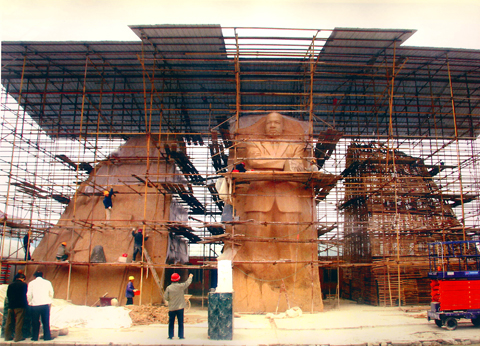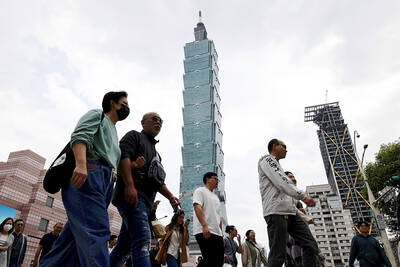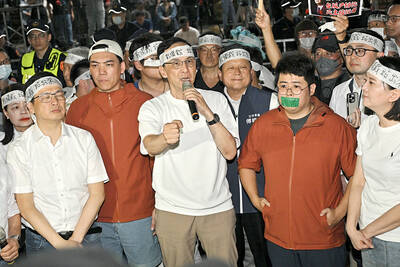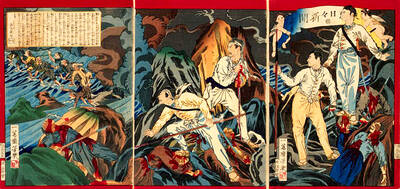The Chinese artist chosen to sculpt a giant statue of Martin Luther King Jr defended his work and charged critics with showing the kind of cultural bias and misunderstanding the civil rights leader fought against.
“I wasn’t trying to express that King was confrontational but that he was thoughtful,” Lei Yixin (雷宜鋅), the sculptor said in a telephone interview.
“He was a global leader and an example for humanity of the struggle for democracy and equality,” he added.

PHOTO: AFP
Some members of the US Commission of Fine Arts have called the work too confrontational and that it “recalls a genre of political sculpture that has recently been pulled down in other countries.”
But the Martin Luther King Jr Memorial Project Foundation has not asked Lei to alter his design for the 8.5m-tall statue, said Lei and Ed Jackson, the foundation’s executive architect. The sculpture is part of a privately funded US$100 million memorial in Washington slated for completion next year.
Lei’s design shows King emerging from but still partially embedded in a block of granite called the Mountain of Despair. King’s pose — based on a photograph taken by Flip Schulke, King’s official photographer — depicts the late civil rights leader with his arms crossed and his lips drawn in concentration.
Jackson said Monday that two members of the commission expressed concerns and he and other executives of the foundation were “trying to … make up in our own minds whether or not the suggestions can be accomplished without compromising the integrity of what Lei has already produced.”
The federal fine arts commission last year initially approved the design of the statue. But the panel, which must approve the monument’s final design, considered the sculpture “inappropriate as an expression of (King’s) legacy” and called for the design to be reworked, according to a letter written last month by commission secretary Thomas Luebke.
The Washington-based commission’s criticisms are the latest in a series of controversies surrounding the statue.
Last year, critics complained that Lei should not have been chosen to lead the project. Ed Dwight, a Colorado-based artist originally retained to help create the statue, has called Lei’s proposed statue “a shrinking, shriveled inadequate personage.”
Atlanta-based artist Gilbert Young said last year that Lei’s selection was “an insult to me and to all black people.” A letter on a Web site he set up — www.kingisours.com — argues that hiring Lei was “a travesty of justice” because Lei had sculpted statues of Mao Zedong (毛澤東), the late Chinese leader.
Mao’s legacy is troubled in China. He made education available to hundreds of millions of Chinese and elevated the position of women in society, but he also spurred violent persecution and oversaw economic failures that led to a massive famine.
In a telephone interview on Saturday, Lei called Young’s attacks biased and contrary to King’s message that people should not be judged on their race or nationality.
“Martin Luther King is a hero for the whole world,” Lei said. “People are still striving for equality and freedom, so his ideals remain strong everywhere.”
He added that while Mao “had made some mistakes, he isn’t as bad as some people think.”
“I understand why (Young) is critical, but he should study about Mao’s life before he judges me,” he said from his home in Changsha, the capital of China’s Hunan Province.
The Martin Luther King Jr National Memorial Project Foundation partly chose Lei because he is one of the world’s top sculptors for large human forms, Jackson said.
The foundation, which evaluated 900 entries from 52 countries, chose Lei’s design because it “captured the essence” of King’s struggle to achieve his ideals, he said.
To prepare for the job, Lei has studied everything he can find about King. As a child, his father read him King’s I Have a Dream speech. Since being chosen to sculpt King, he has searched out dozens of the Civil Rights leader’s less well-known writings.
“What has moved me most is that King combined non-violence and persistence to achieve his goals,” Lei said. “He was steadfast in his ideals.”
“My sculpture is not abstract. It attempts to represent King as the person he was.”
Addressing criticisms that an American should sculpt the statue, Lei said that it is common for top artists to work outside their home nations.
“Some of the world’s top architects are in China and they are contributing to society,” he said. “We shouldn’t look at the color of someone’s skin.”
Born in 1953 in China’s central Hunan Province, Lei taught himself to draw during the Cultural Revolution, when schools were closed and millions of youth were sent to work as farmers.
After universities reopened in 1977, he won a spot at the Guangzhou Academy of Fine Arts. After graduating he taught and worked on commissions, including several statues of Mao.
While many artists depicted Mao as heroic, Lei tried to show him “more as an ordinary person,” he said.
Lei has strong supporters in the US.
Isaac Newton Farris Jr, president and chief executive officer of the King Center in Atlanta and nephew of the civil rights leader, said that Lei’s design correctly depicts King’s legacy.
Jackson said the foundation chose Lei partly because he had experience working with granite, one of the hardest and most durable stones.
Lei said he is preparing a workspace in Hunan Province and will need at least six months to finish the work. “I don’t want this statue to become political,” he said. “I just want to focus on King’s ideals.”

In the March 9 edition of the Taipei Times a piece by Ninon Godefroy ran with the headine “The quiet, gentle rhythm of Taiwan.” It started with the line “Taiwan is a small, humble place. There is no Eiffel Tower, no pyramids — no singular attraction that draws the world’s attention.” I laughed out loud at that. This was out of no disrespect for the author or the piece, which made some interesting analogies and good points about how both Din Tai Fung’s and Taiwan Semiconductor Manufacturing Co’s (TSMC, 台積電) meticulous attention to detail and quality are not quite up to

April 21 to April 27 Hsieh Er’s (謝娥) political fortunes were rising fast after she got out of jail and joined the Chinese Nationalist Party (KMT) in December 1945. Not only did she hold key positions in various committees, she was elected the only woman on the Taipei City Council and headed to Nanjing in 1946 as the sole Taiwanese female representative to the National Constituent Assembly. With the support of first lady Soong May-ling (宋美齡), she started the Taipei Women’s Association and Taiwan Provincial Women’s Association, where she

Chinese Nationalist Party (KMT) Chairman Eric Chu (朱立倫) hatched a bold plan to charge forward and seize the initiative when he held a protest in front of the Taipei City Prosecutors’ Office. Though risky, because illegal, its success would help tackle at least six problems facing both himself and the KMT. What he did not see coming was Taipei Mayor Chiang Wan-an (將萬安) tripping him up out of the gate. In spite of Chu being the most consequential and successful KMT chairman since the early 2010s — arguably saving the party from financial ruin and restoring its electoral viability —

It is one of the more remarkable facts of Taiwan history that it was never occupied or claimed by any of the numerous kingdoms of southern China — Han or otherwise — that lay just across the water from it. None of their brilliant ministers ever discovered that Taiwan was a “core interest” of the state whose annexation was “inevitable.” As Paul Kua notes in an excellent monograph laying out how the Portuguese gave Taiwan the name “Formosa,” the first Europeans to express an interest in occupying Taiwan were the Spanish. Tonio Andrade in his seminal work, How Taiwan Became Chinese,